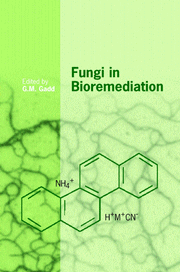Book contents
- Frontmatter
- Contents
- List of contributors
- Preface
- 1 Degradation of plant cell wall polymers
- 2 The biochemistry of ligninolytic fungi
- 3 Bioremediation potential of white rot fungi
- 4 Fungal remediation of soils contaminated with persistent organic pollutants
- 5 Formulation of fungi for in situ bioremediation
- 6 Fungal biodegradation of chlorinated monoaromatics and BTEX compounds
- 7 Bioremediation of polycyclic aromatic hydrocarbons by ligninolytic and non-ligninolytic fungi
- 8 Pesticide degradation
- 9 Degradation of energetic compounds by fungi
- 10 Use of wood-rotting fungi for the decolorization of dyes and industrial effluents
- 11 The roles of fungi in agricultural waste conversion
- 12 Cyanide biodegradation by fungi
- 13 Metal transformations
- 14 Heterotrophic leaching
- 15 Fungal metal biosorption
- 16 The potential for utilizing mycorrhizal associations in soil bioremediation
- 17 Mycorrhizas and hydrocarbons
- Index
5 - Formulation of fungi for in situ bioremediation
Published online by Cambridge University Press: 08 October 2009
- Frontmatter
- Contents
- List of contributors
- Preface
- 1 Degradation of plant cell wall polymers
- 2 The biochemistry of ligninolytic fungi
- 3 Bioremediation potential of white rot fungi
- 4 Fungal remediation of soils contaminated with persistent organic pollutants
- 5 Formulation of fungi for in situ bioremediation
- 6 Fungal biodegradation of chlorinated monoaromatics and BTEX compounds
- 7 Bioremediation of polycyclic aromatic hydrocarbons by ligninolytic and non-ligninolytic fungi
- 8 Pesticide degradation
- 9 Degradation of energetic compounds by fungi
- 10 Use of wood-rotting fungi for the decolorization of dyes and industrial effluents
- 11 The roles of fungi in agricultural waste conversion
- 12 Cyanide biodegradation by fungi
- 13 Metal transformations
- 14 Heterotrophic leaching
- 15 Fungal metal biosorption
- 16 The potential for utilizing mycorrhizal associations in soil bioremediation
- 17 Mycorrhizas and hydrocarbons
- Index
Summary
Introduction
Fungi play a major role in environmental biotechnology. Their morphological, physiological and reproductive strategies make them especially suited for terrestrial habitats. This book is a testament to their multi-faceted role in the biodegradation of natural and xenobiotic compounds and to the major progress that has been made in our ability to use them as agents for the detoxification of hazardous wastes. Nevertheless, the fact remains that most of the successful applications have been performed in laboratory bench-top experiments. Field trials have been plagued by suboptimal results. Physical parameters such as aeration, moisture, nutrient level, pH, temperature and toxic contaminant level interact with living systems in unpredictable ways. Biological parameters such as predation and competition from the resident microbial populations also contribute to the variability of outcomes for in situ bioremediation. The challenge is to create remediation protocols that can be effective despite these numerous uncontrolled variables.
Two major biological strategies have been employed to increase the effectiveness of microbial bioremediation in field trials. The first is the stimulation of the indigenous population, usually through the delivery of a limiting nutrient. This practice is called biostimulation, and successful applications include use in marine oil spills and polycyclic aromatic hydrocarbon (PAH)-contaminated soils (Atlas & Bartha, 1992; Riser-Roberts, 1998). Nitrogen and phosphorus are the most commonly added nutrients (Liebeg & Cutright, 1999).
- Type
- Chapter
- Information
- Fungi in Bioremediation , pp. 97 - 112Publisher: Cambridge University PressPrint publication year: 2001
- 8
- Cited by

